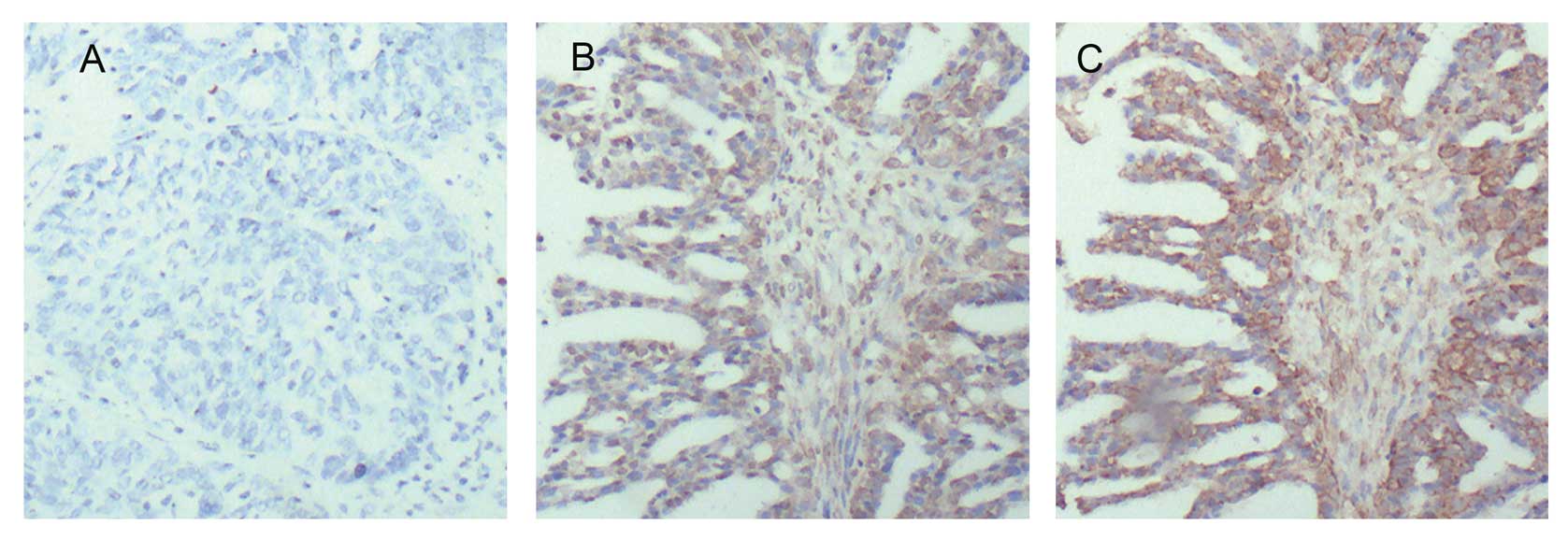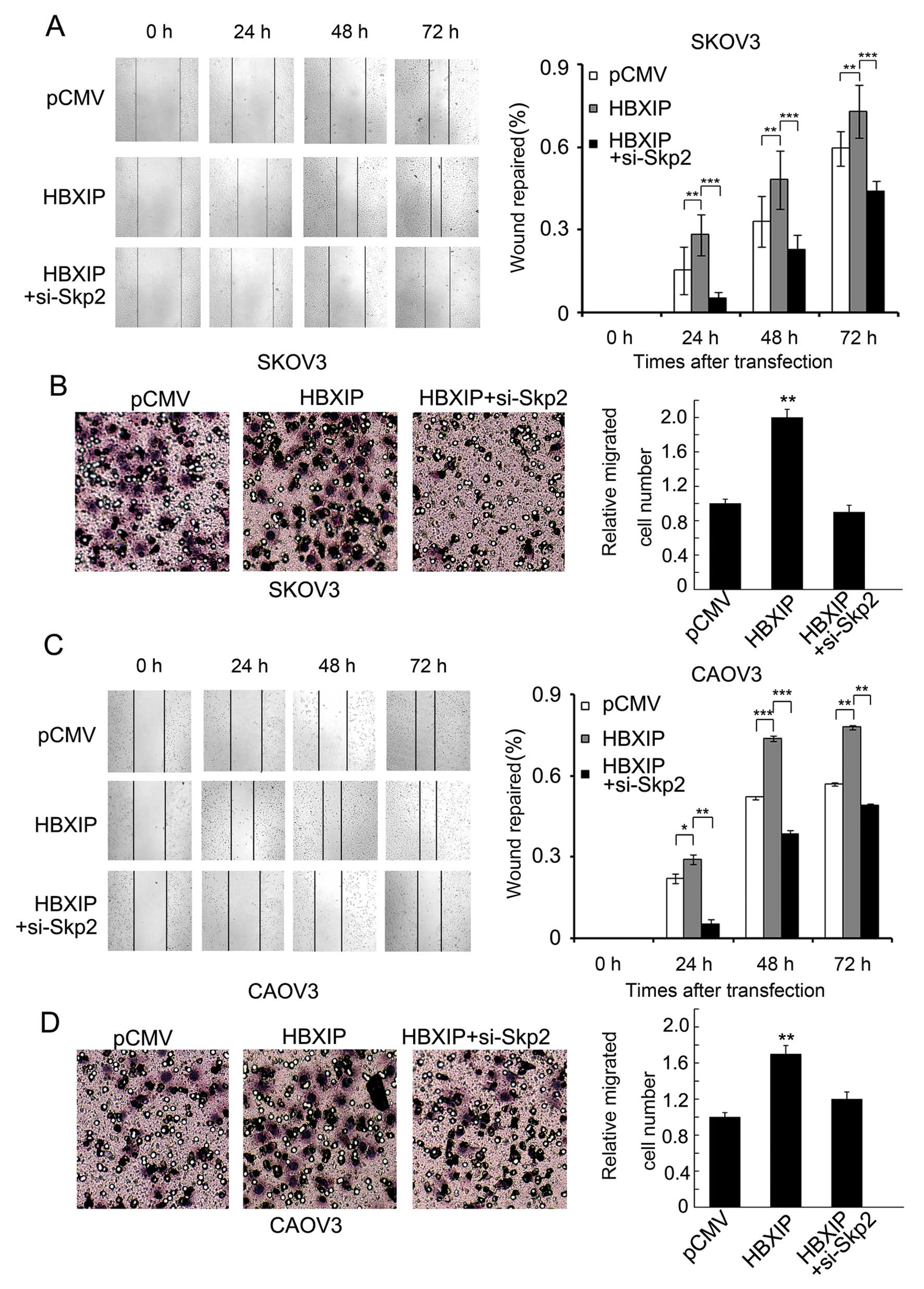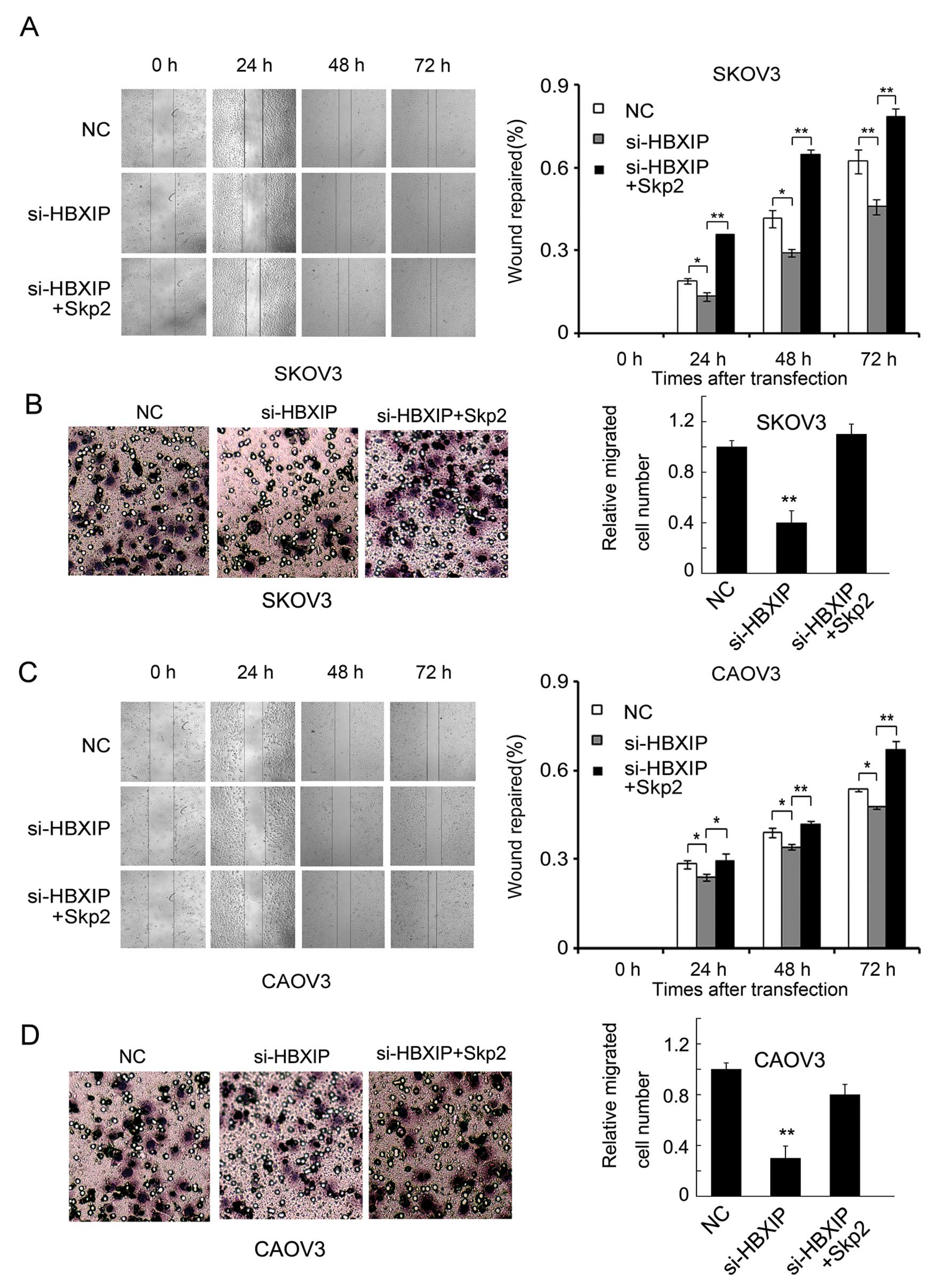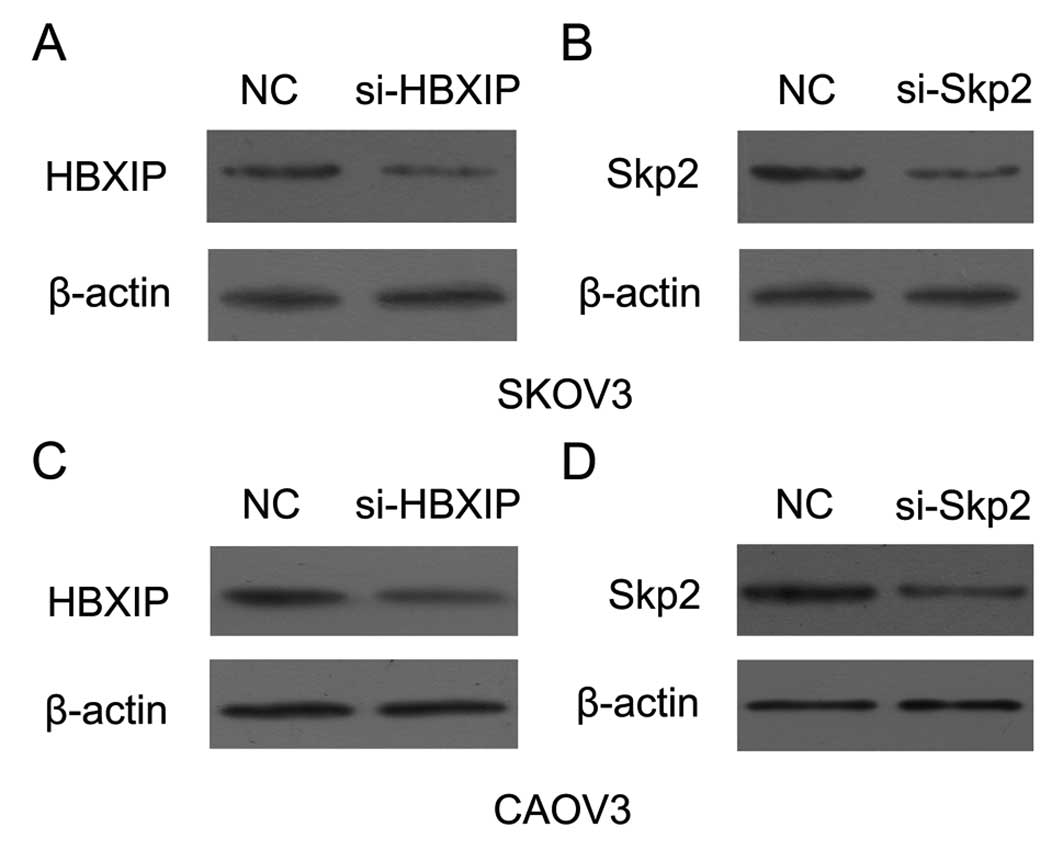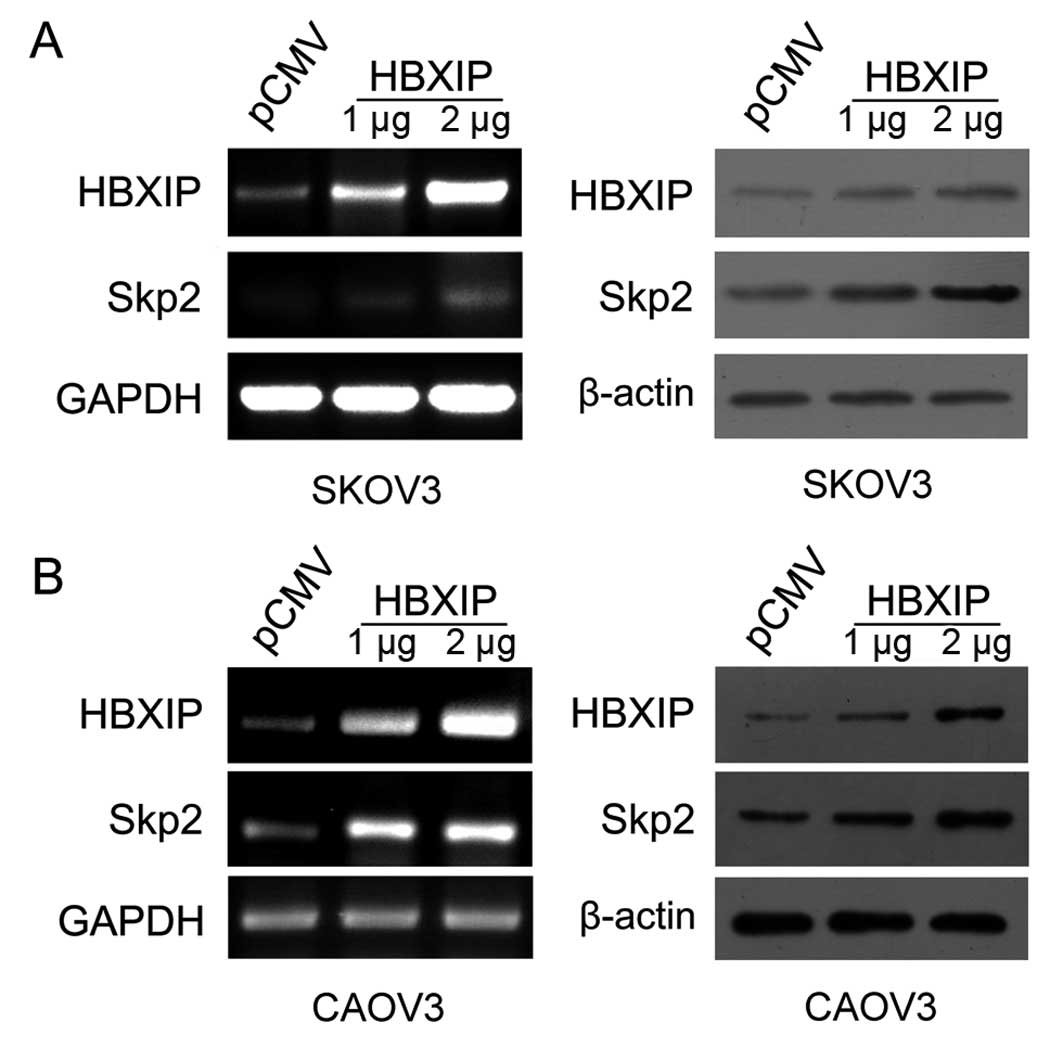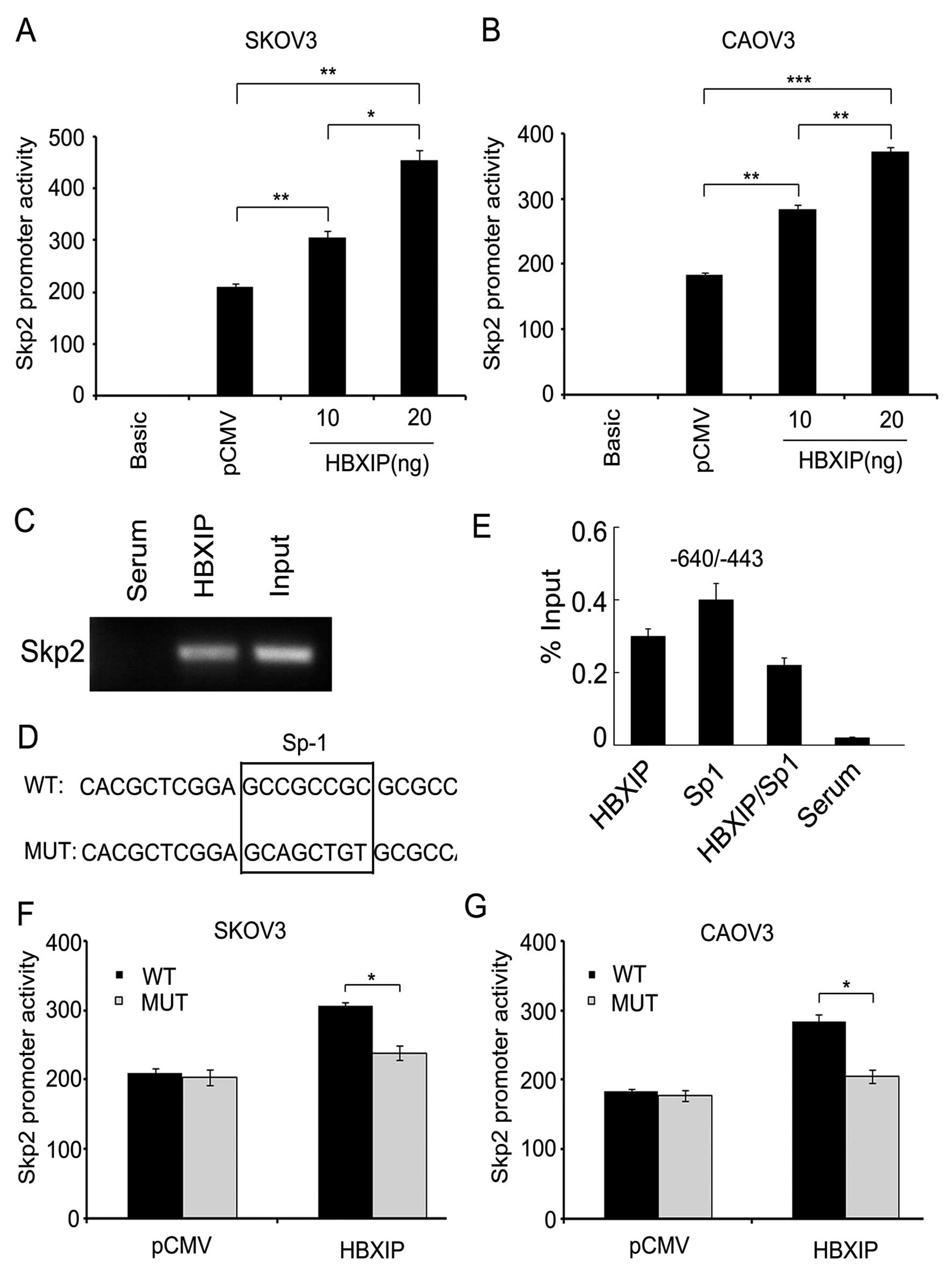The oncoprotein hepatitis B X-interacting protein promotes the migration of ovarian cancer cells through the upregulation of S-phase kinase-associated protein 2 by Sp1
- Authors:
- Published online on: April 29, 2014 https://doi.org/10.3892/ijo.2014.2411
- Pages: 255-263
Abstract
Introduction
Mammalian hepatitis B X-interacting protein (HBXIP) is a conserved 18 kDa protein, which was originally identified because of its interaction with the C-terminus of hepatitis B virus X protein (HBx) (1,2). HBXIP sequences are well conserved among mammalian species, with close orthologues found in all vertebrate species where sequence data exist. HBXIP formed a complex with survivin, an anti-apoptotic protein that is overexpressed in most human cancers, resulting in the suppression of cell apoptosis through the mitochondrial/cytochrome pathway. HBXIP also regulates centrosome duplication, causing excessive centrosome production and multipolar mitotic spindles in HeLa cells (3,4). HBXIP is involved in mTORC1 pathway regulating cell growth (5). Our previous studies reported that HBXIP was able to promote cell proliferation and migration through S100A4 and IL-8 in breast cancer cells (6,7). However, the mechanism by which HBXIP enhances migration of ovarian cancer cells is poorly understood.
S-phase kinase-associated protein 2 (Skp2) belongs to the family of the F-box proteins. Skp2, which was originally discovered by Zhang et al in 1995, because of its ability to interact with the cell cycle protein cyclin A, is necessary for DNA replication (8). The Skp2 protein levels changes during the cell cycle, which is low in early G1 phase, while it is high during G1/S transition (9). This alteration in the Skp2 protein level during cell cycle progression is partly due to a change in its gene expression and protein stability (10). A previous report showed that Skp2 overexpression in prostate cancer cells markedly promoted cancer cell growth and tumorigenesis in a xenograft tumor model (11). And other groups showed that Skp2 deficiency displayed a defect in cell migration and metastasis, while Skp2 overexpression promoted cell migration and invasion (11,12). Inuzuka et al have shown that acetylation of Skp2 enhanced cellular migration through ubiquitination and destruction of E-cadherin (13). Subsequent experiments revealed that Skp2 was involved in cell cycle progression. Cardozo and Pagano have shown that Skp2 plays an important role in governing cell cycle progression and cell survival by promoting the destruction of numerous tumor suppressor proteins, including p27, p21, p57, p130 and FOXO1 (14). Aberrant Skp2 signaling has been implicated as a driving event in tumorigenesis. Overexpression of Skp2 was frequently observed in numerous human cancers, such as ovarian, colorectal, gastric, prostate, lung, sarcoma, breast and other cancers (15–26). These observations suggest that Skp2 may contribute to the development of human cancers. Accumulated evidence suggests that Skp2 displays a proto-oncogenic role in vitro and in vivo. Previous report showed that repamycin, an mTOR inhibitor, could downregulate the expression of Skp2 in breast cancer (27). Thus, we speculate Skp2 may play an important role in the function mediated by HBXIP.
In the present study, we investigated the role of HBXIP and Skp2 in migration of ovarian cancer cells, with the hope that such associations might provide insight into the causal mechanisms by which HBXIP enhances the migration of ovarian cancer cells.
Materials and methods
Immunohistochemistry
The ovarian carcinoma tissue micro-arrays were obtained from the Xi’an Aomei Biotechnology Co., Ltd. (Xi’an, China). These microarrays (catalog no. C1026) were composed of 80 ovarian carcinoma tissue samples (average age 39), which included duplicate core biopsies (1 mm in diameter) from fixed, paraffin-embedded tumors. Immunohistochemical staining of samples were performed as previously reported (28) and the primary antibody of rabbit anti-HBXIP (1:100, Proteintech Group, Chicago, IL, USA) or the primary antibody of rabbit anti-Skp2 (1:30, Boster Group, Wuhan, China) was used. Immunostained slides were evaluated under a microscope. Categorization of immunostaining intensity was performed by three independent observers. The staining levels of HBXIP and Skp2 were classified into three groups using a modified scoring method based on the intensity of staining (0, negative; 1, low; and 2, high) and the percentage of stained cells (0, 0% stained; 1, 1–49% stained; and 2, 50–100% stained). A multiplied score (intensity score x percentage score) lower than 1 was considered to be a negative staining (−), 1 and 2 were considered to be moderate staining (+), and 4 was considered to be intense staining (++).
Cell lines and cell culture
Ovarian cancer cell lines, SKOV3 cells (29) were cultured in RPMI-1640 medium (Gibco-BRL, Grand Island, NY, USA), 10% fetal bovine serum (FBS); CAOV3 cells (29) were cultured in DMEM medium (Gibco-BRL), 10% FBS. 100 U/ml penicillin and 100 μg/ml streptomycin in humidified 5% CO2 at 37°C.
Plasmid construction and small interference RNA (siRNA)
pCMV-tag2B, pGL3-Basic vectors (Promega, Madison, WI, USA), pCMV-HBXIP was maintained in our laboratory (6). The 5′-flanking region (from -1309 to +235 nt) of Skp2 gene was inserted into the KpnI/XhoI site upstream of the luciferase gene in the pGL3-basic vector, termed pGL3-Skp2 promoter. Mutant construction of Skp2 promoter, termed as pGL3-Skp2 promoter mut, carried a series substitution of nucleotides within Sp1 binding site. The complete human Skp2 (GenBank accession no. NC 000005.9) gene was subcloned into pCMV-tag2B vector to generate the pCMV-Skp2 construct. siRNA duplexes targeting human HBXIP (or Skp2) gene and siRNA duplexes with non-specific sequences using as negative control (NC) were synthesized by RiboBio (Guangzhou, China) (3,30). All primers and siRNA sequences are listed in Table I.
Transfection
One day before transfection, cells were harvested and seeded into 6- or 24-well plates. Cells were transfected with plasmid or siRNAs using Lipofectamine 2000 reagent (Invitrogen, Carlsbad, CA, USA) according to the manufacturer’s protocol.
Wound-healing assay and Transwell migration assay
Cells transfected with plasmid of HBXIP, plasmid of HBXIP and siRNAs of Skp2, siRNAs of HBXIP, siRNAs of HBXIP and pCMV-Skp2 were seeded in a 6-well plate and cultured for 24 h to form confluent monolayers. A wound was created by dragging a pipette tip through the monolayer, and plates were washed using pre-warmed PBS to remove cellular debris. Wound images were photographed at 0, 24, 48 and 72 h after wounding. The wound gaps were measured at each time point. For Transwell migration assay using SKOV3 and CAOV3 cells with indicated treatment, 5×105 cells were plated on 8 μm Transwell filters (Corning Incorporated, Corning, NY, USA). The cells were induced to migrate towards medium containing 10% FBS for 20 h. Non-migrating cells were removed with a cotton swab. The remaining cells were fixed, stained with hematoxylin and eosin, and analysed by a bright-field microscope.
RNA extraction and reverse-transcription polymerase chain reaction (RT-PCR)
Total RNA of cells was extracted using TRIzol reagent (Invitrogen). First-strand cDNA was synthesized by PrimeScript reverse transcriptase (Takara Bio, Dalian, China) and oligo (dT) following the manufacturer’s instructions. The primers are listed in Table I.
Western blot analysis
Western blot analysis was carried out with standard protocols. Primary antibodies used were rabbit anti-Skp2 (1:300, Boster Group), rabbit anti-HBXIP (1:1,000, Proteintech Group), and mouse anti-β-actin (1:800, Sigma-Aldrich, St. Louis, MO, USA). All experiments were repeated 3 times.
Luciferase reporter gene assays
For luciferase reporter gene assays, the ovarian cancer cells were transfected with plasmids encoding HBXIP by Lipofectamine 2000. The luciferase activities were determined 48 h after transfection, and the results are the average of 3 independent repeats. The luciferase activities in the cell lysates were measured by a dual luciferase reporter assay kit (Promega), and the luciferase activity was normalized with renilla luciferase activity.
Chromatin immunoprecipitation (ChIP) and ReChIP assay
The ChIP assay was performed using the EpiQuik™ chromatin immunoprecipitation kit from Epigentek Group Inc (Farmingdale, NY, USA) according to the published methods (6,31). Protein-DNA complexes were immunoprecipitated with HBXIP antibodies, whereas rabbit preimmune serum served as a control. DNA from input or immunoprecipitated samples was assayed using SYBR-Green-based quantitative PCR with specific primers designed to amplify the Skp2 promoter around the SREs. ChIP/ReChIP: ChIP was performed as above, binding complexes from the first immunoprecipitation were eluted from the sepharose beads using Re-ChIP buffer. The eluted protein-DNA complexes were diluted in radioimmunoprecipitation buffer and resubjected to ChIP using a different antibody.
Statistical analysis
Each experiment was repeated at least three times. Statistical significance was assessed by comparing mean values (± SD) using a Student’s t-test for independent groups or pairing χ2 for dependent groups and was assumed for *P<0.05, **P<0.01 and ***P<0.001.
Results
The expression of HBXIP is positively associated with that of Skp2 in clinical ovarian cancer tissues
Our previous reports showed that HBXIP was overexpressed in breast cancer and other cancer cells. However, there is no report concerning the expression of HBXIP in ovarian cancer. In this study, we examined the expression of HBXIP in ovarian cancer. The data revealed that HBXIP was overexpressed in ovarian cancer tissue (Fig. 1). It has been reported that Skp2 is also over-expressed in ovarian cancer tissues (23). Thus, we supposed that overexpression of Skp2 might be correlated with enhanced HBXIP in ovarian cancer. Then, we investigated the expression correlation between HBXIP and Skp2 by IHC using tissue microarrays from the same tissue paraffin block. Our data showed that the positive rate of HBXIP was 75% (60/80) in clinical ovarian cancer tissue samples, and the positive rate of Skp2 was 81.67% (49/60) in the HBXIP-positive specimens (Fig. 1). Pairing χ2 analysis showed that there was no significant difference between the positive rate of HBXIP and that of Skp2 in the tissues (P>0.05, Table II), suggesting that the expression of Skp2 is relevant to that of HBXIP in ovarian cancer tissues. Additionally, in this study, IHC staining showed that the expression of HBXIP could be observed in both cytoplasm and nucleus in ovarian cancer tissues (Fig. 1B). We also observed that Skp2 was expressed in both cytoplasm and nucleus in ovarian cancer tissues (Fig. 1C), which is consistent with a previous study (32). Thus, we speculated that HBXIP might be involved in the transcriptional regulation of Skp2.
Skp2 is responsible for HBXIP-enhanced migration of ovarian cancer cells in vitro
Cell migration is an essential process in cancer metastasis and HBXIP can promote cell migration in breast cancer cells (6,7). Other reports showed that Skp2 can modulate cell migration of breast cancer, prostate cancer and myxofibrosarcoma (18,21,22,24). Thus, we supposed that Skp2 might be involved in the migration enhanced by HBXIP. Wound-healing and Transwell assays showed that treatment with plasmid encoding HBXIP enhanced the migration of SKOV3 cells, while additionally treated with Skp2 siRNAs abolished the effect (Fig. 2A and B). Furthermore, we performed the same assay using another ovarian cancer cell line CAOV3, and obtained similar results (Fig. 2C and D). We found that the inhibited migration of SKOV3 ovarian cancer cells induced by HBXIP siRNAs, was rescued by the overexpression of Skp2 (Fig. 3A and B). Similar results occurred in CAOV3 ovarian cancer cell line (Fig. 3C and D). Furthermore, as shown in Fig. 4, the RNA interference of HBXIP (or Skp2) decreased the expression of protein levels in SKOV3 and CAOV3 cells. Thus, our data suggest that HBXIP promotes the migration of ovarian cancer cells through Skp2 in vitro.
HBXIP upregulates the expression of Skp2 in ovarian cancer cells
Next, we evaluated whether HBXIP was able to upregulate Skp2 in ovarian cancer cell lines. After transfection with plasmid encoding HBXIP, we observed that the levels of mRNA and protein of Skp2 were upregulated by HBXIP in SKOV3 and CAOV3 cell lines in a dose-dependent manner (Fig. 5). Thus, we verified that HBXIP was able to upregulate Skp2 in ovarian cancer cells.
HBXIP activates Skp2 promoter via transcription factor Sp1
Furthermore, to explore the mechanism by which HBXIP upregulated Skp2, we cloned the promoter region of Skp2 (-1309/+235) into pGL3-Basic plasmid. Luciferase reporter gene assays showed that HBXIP could increase the promoter activities of Skp2 in SKOV3 or CAOV3 ovarian cancer cells in a dose-dependent manner (Fig. 6A and B), suggesting that HBXIP is capable of activating the Skp2 promoter in the ovarian cancer cells. Next, we investigated the underlying mechanism by which HBXIP activates Skp2 promoter. To map the HBXIP binding site in Skp2 promoter, we designed a series of primers of Skp2 promoter fragments in 5′-flanking region, including the fragments −776/−567, −640/−443 and −464/−250. Interestingly, ChIP assays showed that HBXIP was able to occupy the Skp2 promoter fragment −640/−443 (Fig. 6C), suggesting that the −640/−443 region of Skp2 promoter is the regulatory target sequence of HBXIP. Then, we used online promoter analysis tool Search Promoter Site (http://alggen.lsi.upc.es/cgibin/promo_v3/promo/promoinit.cgi?dir-DB=TF8.3) to predict the putative transcription factor binding sites in the −640/−443 promoter region of Skp2. Strikingly, we observed a putative Sp1 binding site in the region (Fig. 6D). ChIP/ReChIP assay showed that HBXIP and Sp1 were able to form a transcriptional complex on the Skp2 promoter (Fig. 6E). Luciferase reporter gene assays showed that HBXIP failed to work when the Sp1 binding site in Skp2 promoter was mutated (Fig. 6F and G). Thus, we conclude that HBXIP activates Skp2 promoter activity through the transcription factor Sp1.
Discussion
Our studies have showed that HBXIP is a novel oncoprotein. HBXIP was highly expressed in breast cancer tissues and metastatic lymph node tissues and significantly associated with the growth and metastasis of breast cancer cells (6,7,33). However, the expression and role of HBXIP in ovarian cancer cells is poorly understood. Many studies have shown that over-expression of Skp2 is observed in a variety of human cancers, including ovarian cancer, gastric cancer, colorectal cancer, prostate cancer, sarcoma, breast cancer, lung cancer, pancreatic cancer and other cancers (15,26). In addition, Skp2 has an established role in the migration of cancer cells. Therefore, we are interested in the effect of HBXIP on cell migration in ovarian cancer and the role Skp2 plays in the signaling pathway.
Latest study showed that HBXIP was a regulator components that is required for mTORC1 activation by amino acids (5). Cross-talk between mTOR pathway and Skp2 pathway has been reported recently. Shapira et al showed that repamycin, an mTOR inhibitor, could downregulate the expression of Skp2 in breast cancer (27). Shigemasa et al proved that Skp2 was expressed in nearly half of the 91 ovarian adenocarcinomas (23). In this study, we first observed that HBXIP is overexpressed in ovarian cancer tissues. We noted that the expression of HBXIP was significantly correlated with Skp2 in ovarian cancer tissues.
Skp2 overexpression has been correlated with tumor progression such as stage and survival in ovarian cancer and other human cancers (16), indicating that Skp2 may be important in cancer cell migration, invasion and metastasis. Previous reports showed that Skp2 deficiency displayed a defect in cell migration and metastasis, while Skp2 overexpression promoted cell migration and invasion (11,12). It has also been shown that acetylation of Skp2 enhanced cellular migration (13). Consistent with this notion, we found that Skp2 is responsible for the enhanced migration of ovarian cancer cells mediated by HBXIP.
We observed that HBXIP was able to upregulate the mRNA and protein levels of Skp2 in ovarian cancer cells. Next, we sought to elucidate the underlying mechanism by which HBXIP upregulates Skp2. We previously observed the nuclear localization of HBXIP in MCF-7 cells (6), we found a similar phenomenon in ovarian cancer tissues, implying that HBXIP may be involved in the transcriptional regulation of Skp2. Then, we predicted the putative transcription factor binding sites in the -640/-443 promoter region of Skp2. Strikingly, we found a Sp1 binding site in the region. Sp1 is a transcription factor that either enhance or repress the activity of promoters of genes involved in differentiation, cell cycle progression and oncogenesis (34). In comparison to normal tissues or cells, Sp1 level is greater in breast carcinomas, thyroid cancer, hepatocellular carcinomas, pancreatic cancer, colorectal cancer, gastric cancer and lung cancer (34–37). Sp1 is also overexpressed in ovarian cancer (38) and plays an important role in the process of cancer. We found that HBXIP was able to bind to the Skp2 promoter region through interacting with Sp1 by ChIP/ReChIP assays. We further demonstrated that HBXIP activated Skp2 promoter through the transcription factor Sp1. Thus, we report that the transcription factor Sp1 plays a role in regulating Skp2 mediated by HBXIP in ovarian cancer cells.
In summary, our finding indicates that HBXIP promotes the migration of ovarian cancer cells through upregulating Skp2, in which HBXIP activates the transcription of Skp2 through interaction with transcription factor Sp1. HBXIP may act as a co-activator of transcription factors to upregulate many genes in the development of cancer. Therefore, our finding provides new insight into the mechanism of HBXIP in promotion of migration of ovarian cancer cells.
Acknowledgements
This study was supported by grants from the National Basic Research Program of China (973 Program, nos. 2011CB512113 and 2009CB521702) and National Natural Science Foundation of China (nos. 81071623, 81071624 and 81272217).
References
|
Melegari M, Scaglioni PP and Wands JR: Cloning and characterization of a novel hepatitis B virus x binding protein that inhibits viral replication. J Virol. 72:1737–1743. 1998.PubMed/NCBI | |
|
Lok AS: Hepatitis B infection: pathogenesis and management. J Hepatol. 32:89–97. 2000. View Article : Google Scholar : PubMed/NCBI | |
|
Fujii R, Zhu C, Wen Y, Marusawa H, Bailly-Maitre B, Matsuzawa S, Zhang H, Kim Y, Bennett CF, Jiang W and Reed JC: HBXIP, cellular target of hepatitis B virus oncoprotein, is a regulator of centrosome dynamics and cytokinesis. Cancer Res. 66:9099–9107. 2006. View Article : Google Scholar : PubMed/NCBI | |
|
Wen Y, Golubkov VS, Strongin AY, Jiang W and Reed JC: Interaction of hepatitis B viral oncoprotein with cellular target HBXIP dysregulates centrosome dynamics and mitotic spindle formation. J Biol Chem. 283:2793–2803. 2008. View Article : Google Scholar : PubMed/NCBI | |
|
Bar-Peled L, Schweitzer LD, Zoncu R and Sabatini DM: Ragulator is a GEF for the Rag GTPases that signal amino acid levels to mTORC1. Cell. 150:1196–1208. 2012. View Article : Google Scholar : PubMed/NCBI | |
|
Liu S, Li L, Zhang Y, Zhang Y, Zhao Y, You X, Lin Z, Zhang X and Ye L: The oncoprotein HBXIP uses two pathways to up-regulate S100A4 in promotion of growth and migration of breast cancer cells. J Biol Chem. 287:30228–30239. 2012. View Article : Google Scholar : PubMed/NCBI | |
|
Hu N, Zhang J, Cui W, Kong G, Zhang S, Yue L, Bai X, Zhang Z, Zhang W, Zhang X and Ye L: miR-520b regulates migration of breast cancer cells by targeting hepatitis B X-interacting protein and interleukin-8. J Biol Chem. 286:13714–13722. 2011. View Article : Google Scholar : PubMed/NCBI | |
|
Zhang H, Kobayashi R, Galaktionov K and Beach D: p19Skp1 and p45Skp2 are essential elements of the cyclin A-CDK2 S phase kinase. Cell. 82:915–925. 1995. View Article : Google Scholar | |
|
Kurland JF and Tansey WP: Crashing waves of destruction: the cell cycle and APC(Cdh1) regulation of SCF(Skp2). Cancer Cell. 5:305–306. 2004. View Article : Google Scholar : PubMed/NCBI | |
|
Suzuki S, Fukasawa H, Misaki T, Togawa A, Ohashi N, Kitagawa K, Kotake Y, Liu N, Niida H, Nakayama K, Nakayama KI, Yamamoto T and Kitagawa M: The amelioration of renal damage in Skp2-deficient mice canceled by p27 Kip1 deficiency in Skp2−/−p27−/−mice. PLoS One. 7:e362492012.PubMed/NCBI | |
|
Lin HK, Wang G, Chen Z, Teruya-Feldstein J, Liu Y, Chan CH, Yang WL, Erdjument-Bromage H, Nakayama KI, Nimer S, Tempst P and Pandolfi PP: Phosphorylation-dependent regulation of cytosolic localization and oncogenic function of Skp2 by Akt/PKB. Nat Cell Biol. 11:420–432. 2009. View Article : Google Scholar : PubMed/NCBI | |
|
Chan CH, Lee SW, Li CF, Wang J, Yang WL, Wu CY, Wu J, Nakayama KI, Kang HY, Huang HY, Hung MC, Pandolfi PP and Lin HK: Deciphering the transcriptional complex critical for RhoA gene expression and cancer metastasis. Nat Cell Biol. 12:457–467. 2010. View Article : Google Scholar : PubMed/NCBI | |
|
Inuzuka H, Gao D, Finley LW, Yang W, Wan L, Fukushima H, Chin YR, Zhai B, Shaik S, Lau AW, Wang Z, Gygi SP, Nakayama K, Teruya-Feldstein J, Toker A, Haigis MC, Pandolfi PP and Wei W: Acetylation-dependent regulation of Skp2 function. Cell. 150:179–193. 2012. View Article : Google Scholar : PubMed/NCBI | |
|
Cardozo T and Pagano M: The SCF ubiquitin ligase: insights into a molecular machine. Nat Rev Mol Cell Biol. 5:739–751. 2004. View Article : Google Scholar : PubMed/NCBI | |
|
Bretones G, Acosta JC, Caraballo JM, Ferrándiz N, Gómez-Casares MT, Albajar M, Blanco R, Ruiz P, Hung WC, Albero MP, Perez-Roger I and León J: SKP2 oncogene is a direct MYC target gene and MYC down-regulates p27(KIP1) through SKP2 in human leukemia cells. J Biol Chem. 286:9815–9825. 2011. View Article : Google Scholar : PubMed/NCBI | |
|
Einama T, Kagata Y, Tsuda H, Morita D, Ogata S, Ueda S, Takigawa T, Kawarabayashi N, Fukatsu K, Sugiura Y, Matsubara O and Hatsuse K: High-level Skp2 expression in pancreatic ductal adenocarcinoma: correlation with the extent of lymph node metastasis, higher histological grade, and poorer patient outcome. Pancreas. 32:376–381. 2006. View Article : Google Scholar | |
|
Hung WC, Tseng WL, Shiea J and Chang HC: Skp2 overexpression increases the expression of MMP-2 and MMP-9 and invasion of lung cancer cells. Cancer Lett. 288:156–161. 2010. View Article : Google Scholar : PubMed/NCBI | |
|
Li CF, Wang JM, Kang HY, Huang CK, Wang JW, Fang FM, Wang YH, Wu WR, Li SH, Yu SC, Lee JC, Lan J, Shiue YL, Wu LC and Huang HY: Characterization of gene amplification-driven SKP2 overexpression in myxofibrosarcoma: potential implications in tumor progression and therapeutics. Clin Cancer Res. 18:1598–1610. 2012. View Article : Google Scholar : PubMed/NCBI | |
|
Lim MS, Adamson A, Lin Z, Perez-Ordonez B, Jordan RC, Tripp S, Perkins SL and Elenitoba-Johnson KS: Expression of Skp2, a p27(Kip1) ubiquitin ligase, in malignant lymphoma: correlation with p27(Kip1) and proliferation index. Blood. 100:2950–2956. 2002. View Article : Google Scholar : PubMed/NCBI | |
|
Lu M, Zhao Y, Xu F, Wang Y, Xiang J and Chen D: The expression and prognosis of FOXO3a and Skp2 in human ovarian cancer. Med Oncol. 29:3409–3415. 2012. View Article : Google Scholar : PubMed/NCBI | |
|
Masuda TA, Inoue H, Sonoda H, Mine S, Yoshikawa Y, Nakayama K, Nakayama K and Mori M: Clinical and biological significance of S-phase kinase-associated protein 2 (Skp2) gene expression in gastric carcinoma: modulation of malignant phenotype by Skp2 overexpression, possibly via p27 proteolysis. Cancer Res. 62:3819–3825. 2002. | |
|
Shapira M, Ben-Izhak O, Linn S, Futerman B, Minkov I and Hershko DD: The prognostic impact of the ubiquitin ligase subunits Skp2 and Cks1 in colorectal carcinoma. Cancer. 103:1336–1346. 2005. View Article : Google Scholar : PubMed/NCBI | |
|
Shigemasa K, Gu L, O’Brien TJ and Ohama K: Skp2 over-expression is a prognostic factor in patients with ovarian adenocarcinoma. Clin Cancer Res. 9:1756–1763. 2003.PubMed/NCBI | |
|
Sonoda H, Inoue H, Ogawa K, Utsunomiya T, Masuda TA and Mori M: Significance of skp2 expression in primary breast cancer. Clin Cancer Res. 12:1215–1220. 2006. View Article : Google Scholar : PubMed/NCBI | |
|
Traub F, Mengel M, Luck HJ, Kreipe HH and von Wasielewski R: Prognostic impact of Skp2 and p27 in human breast cancer. Breast Cancer Res Treat. 99:185–191. 2006. View Article : Google Scholar : PubMed/NCBI | |
|
Wang Z, Gao D, Fukushima H, Inuzuka H, Liu P, Wan L, Sarkar FH and Wei W: Skp2: a novel potential therapeutic target for prostate cancer. Biochim Biophys Acta. 1825:11–17. 2012.PubMed/NCBI | |
|
Shapira M, Kakiashvili E, Rosenberg T and Hershko DD: The mTOR inhibitor rapamycin down-regulates the expression of the ubiquitin ligase subunit Skp2 in breast cancer cells. Breast Cancer Res. 8:R462006. View Article : Google Scholar : PubMed/NCBI | |
|
Zhang X, Dong N, Yin L, Cai N, Ma H, You J, Zhang H, Wang H, He R and Ye L: Hepatitis B virus X protein upregulates survivin expression in hepatoma tissues. J Med Virol. 77:374–381. 2005. View Article : Google Scholar | |
|
Al-Alem L, Southard RC, Kilgore MW and Curry TE: Specific thiazolidinediones inhibit ovarian cancer cell line proliferation and cause cell cycle arrest in a PPARgamma independent manner. PLoS One. 6:e161792011. View Article : Google Scholar : PubMed/NCBI | |
|
Liang M, Liang YY, Wrighton K, Ungermannova D, Wang XP, Brunicardi FC, Liu X, Feng XH and Lin X: Ubiquitination and proteolysis of cancer-derived Smad4 mutants by SCFSkp2. Mol Cell Biol. 24:7524–7537. 2004. View Article : Google Scholar : PubMed/NCBI | |
|
Nelson JD, Denisenko O and Bomsztyk K: Protocol for the fast chromatin immunoprecipitation (ChIP) method. Nat Protoc. 1:179–185. 2006. View Article : Google Scholar | |
|
Hu D, Liu W, Wu G and Wan Y: Nuclear translocation of Skp2 facilitates its destruction in response to TGFbeta signaling. Cell Cycle. 10:285–292. 2011. View Article : Google Scholar : PubMed/NCBI | |
|
Wang FZ, Sha L, Ye LH and Zhang XD: Promotion of cell proliferation by HBXIP via upregulation of human telomerase reverse transcriptase in human mesenchymal stem cells. Acta Pharmacol Sin. 29:83–89. 2008. View Article : Google Scholar | |
|
Davie JR, He S, Li L, Sekhavat A, Espino P, Drobic B, Dunn KL, Sun JM, Chen HY, Yu J, Pritchard S and Wang X: Nuclear organization and chromatin dynamics - Sp1, Sp3 and histone deacetylases. Adv Enzyme Regul. 48:189–208. 2008. View Article : Google Scholar : PubMed/NCBI | |
|
Zheng Y, Ritzenthaler JD, Sun X, Roman J and Han S: Prostaglandin E2 stimulates human lung carcinoma cell growth through induction of integrin-linked kinase: the involvement of EP4 and Sp1. Cancer Res. 69:896–904. 2009. View Article : Google Scholar : PubMed/NCBI | |
|
Kong LM, Liao CG, Chen L, Yang HS, Zhang SH, Zhang Z, Bian HJ, Xing JL and Chen ZN: Promoter hypomethylation up-regulates CD147 expression through increasing Sp1 binding and associates with poor prognosis in human hepatocellular carcinoma. J Cell Mol Med. 15:1415–1428. 2011. View Article : Google Scholar : PubMed/NCBI | |
|
Chuang JY, Wu CH, Lai MD, Chang WC and Hung JJ: Overexpression of Sp1 leads to p53-dependent apoptosis in cancer cells. Int J Cancer. 125:2066–2076. 2009. View Article : Google Scholar : PubMed/NCBI | |
|
Previdi S, Malek A, Albertini V, Riva C, Capella C, Broggini M, Carbone GM, Rohr J and Catapano CV: Inhibition of Sp1-dependent transcription and antitumor activity of the new aureolic acid analogues mithramycin SDK and SK in human ovarian cancer xenografts. Gynecol Oncol. 118:182–188. 2010. View Article : Google Scholar : PubMed/NCBI |



